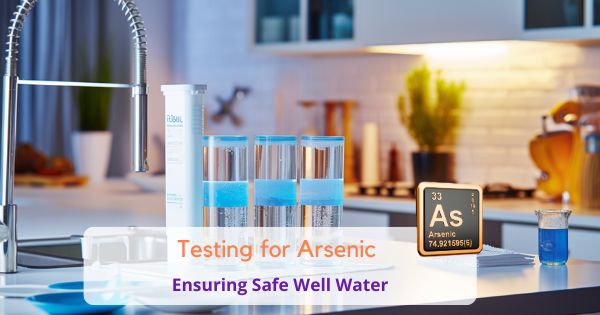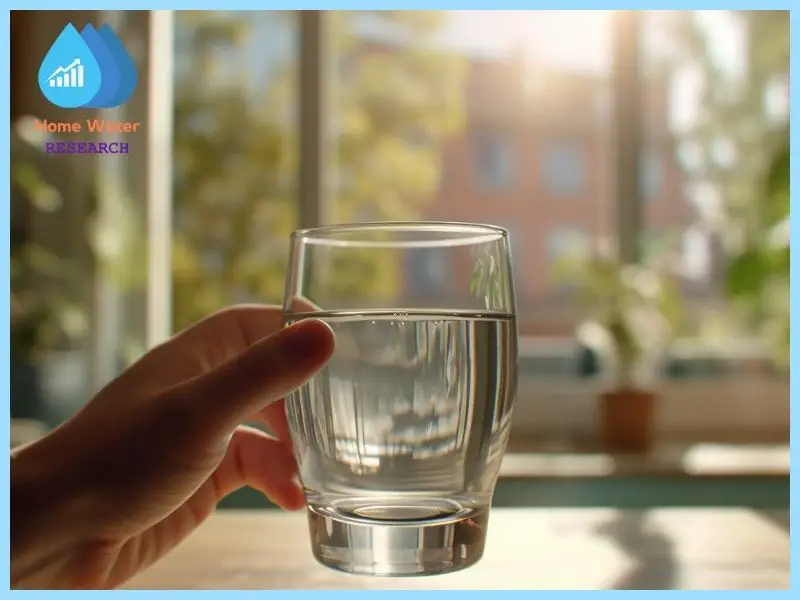
By testing for arsenic in water at different times of the year, we can account for seasonal variations and make informed decisions about our water quality. However, it’s important to note that even if the test shows zero arsenic, it doesn’t guarantee absolute safety in the future.
In this article, we will explore the importance of testing for arsenic in well water and discuss the steps we can take to ensure its safety.
Key Takeaways: Testing for Arsenic in Water
- Regular testing of well water, every three to five years at minimum, is crucial for ensuring its safety and identifying changes in arsenic levels.
- Arsenic exposure can come from various sources, and even small amounts can pose health risks.
- Taking action to reduce arsenic levels, such as using water treatment methods and installing filtration systems, is essential.
- Get a Total Arsenic Test from My Tap Score and have your results within a week.
The Importance of Testing
Regular testing is crucial for everyone to ensure the safety of our well water. It is the only way to know if arsenic or other contaminants are present. Testing should be done every 3-5 years and at different times of the year to account for seasonal variations.
By testing regularly, we can identify any changes in arsenic levels and take necessary action to reduce them. The benefits of regular testing are immense. It helps us protect our health and the health of our loved ones. Arsenic, even in small amounts, can have potential health risks, including an increased risk of cancer, skin problems, and cardiovascular issues.
How to Test for Arsenic
There are different levels of testing for arsenic. They start with the least involved (and least expensive): Observational Self Testing. Then there are three other ‘levels,’ working their way up in cost and complexity to fully-certified water testing (level 4).
| Testing Level | Description | Applicability | Advantages | Limitations |
|---|---|---|---|---|
| Self-Testing (Level 1) | Observe indicators and health symptoms | Initial screening | Cost-effective and simple | Not conclusive, need further investigation |
| DIY Testing (Level 2) | Use DIY kit to confirm arsenic presence | Confirm presence of arsenic | Convenient and affordable | Accuracy may vary with DIY kits |
| Lab Testing (Level 3) | Send samples to accredited lab | Reliable information | Certified professionals | Additional cost and time |
| Certified Testing (Level 4) | Highest accuracy with professionals | Legal cases, maximum accuracy | Credible and precise results | Expensive, may need expertise |
For most people, we recommend DIY testing with a reliable company like MyTapScore.
MyTapScore is a simple, affordable, and accurate way to test your water quality and get personalized recommendations for treatment.
They have a Total Arsenic Test specifically for people with wells who are concerned about arsenic. And if you want full peace of mind, their essential well water test looks for all common well water contaminants.
Visit the MyTapScore website to learn more.
Observational Self-Testing (Level 1)

Arsenic is a sneaky contaminant that doesn’t leave any noticeable taste, odor, or appearance in your water. So, how can you tell if it’s lurking in your water supply? Here are a few indicators to look out for:
- Elevated levels of iron and manganese: Arsenic shares common geological sources with these elements. So, if your drinking water has high levels of iron and manganese, it’s worth considering the possibility of arsenic contamination.
- Health symptoms: Pay attention to any symptoms you or other water source consumers may be experiencing. Arsenic exposure can cause a range of health issues, so if you notice anything unusual, it’s worth investigating further.
- Location matters: Take a look at the map provided by the US Geological Survey (USGS) to see if your area is known to have elevated levels of arsenic. Widespread high concentrations have been found in the West, the Midwest, parts of Texas, and the Northeast. So, if you’re in one of these areas, it’s definitely worth considering arsenic as a potential culprit.
Do-It-Yourself (DIY) Testing for Arsenic in Water (Level 2)
This involves using a testing kit to perform DIY water testing right in the comfort of your home.
Level 2 testing is all about confirming your observations from Level 1 and getting more specific information about the contaminants in your water. It’s like putting on your lab coat and becoming a water scientist!
When it comes to arsenic, there are a few things you should keep in mind during Level 2 testing:
- Consider the mapping information: If the general mapping information suggests that your area may have an arsenic problem, it’s definitely worth investigating further.
- Look out for specific indicators: If you’re experiencing water issues related to iron, manganese, or sulfur, there’s a chance that arsenic might be involved too. Also, if your water comes from a deep well or is located near known hazards like old apple orchards, civil war era cemeteries, landfills, or commercial facilities that use arsenic, it’s worth considering arsenic as a potential culprit.
As mentioned above, we recommend ordering a Total Arsenic Test or an Essential Well Test from MyTapScore – the leading home water quality test kit provider.
If your test results reveal the presence of arsenic or any other contaminants that are cause for concern, you can either proceed to determine the best treatment options or continue to Level 3 testing.
Informational Water Testing (Level 3)
This is where you take water testing to the next level with the help of an accredited Water Testing Laboratory.
You can order a testing kit that will allow you to prepare your water sample and submit it to the lab for analysis
With Level 3 testing, you can have the peace of mind that your water sample is being analyzed by a certified professional. This is especially important if your Level 2 testing revealed the presence of contaminants that cause concern.
Certified Water Testing (Level 4)
This level involves certified testing, where a water professional comes to your home, prepares the water sample, and works with an accredited laboratory to certify your test results.

Certified testing gives you the highest level of assurance in the accuracy of your test results and can also be used as a document in legal cases. So, if you’re looking for that extra level of certainty, Level 4 testing is the way to go.
When it comes to arsenic, specialized sampling, and testing may be needed to determine the arsenic’s specific species and oxidation state. This information is important because it can affect the treatment process. So, it’s worth checking for nuisance bacteria if you’re experiencing odors, high standard plate counts, high chlorine demand, and/or slime coatings.
Understanding Arsenic Exposure
Understanding arsenic exposure is crucial when it comes to ensuring safe well water.
Arsenic in drinking water cannot be seen, tasted, or smelled, making regular testing the only way to know if your well water is contaminated. It does not guarantee safety even if arsenic levels are zero or undetectable.
Total arsenic exposure can happen through various sources, including drinking water, food, and the environment. Long-term exposure to arsenic has been linked to serious health problems such as cancer, cardiovascular disease, and neurological issues.
Taking action to reduce arsenic levels and regularly testing for contamination is essential for maintaining the health and safety of your well water.
Taking Action to Reduce Levels
To address high levels of arsenic contamination, we can take action to reduce the presence of this harmful substance in our environment.
Reducing contamination is crucial for ensuring the safety of our well water.
One effective way to achieve this is by implementing proper water treatment methods. For example, installing a water filtration system specifically designed to remove arsenic can significantly reduce its levels in our drinking water.
Additionally, practicing responsible waste management can prevent the release of arsenic into the environment. Proper disposal of hazardous materials and avoiding the use of arsenic-containing products can minimize its impact on our surroundings.
By actively taking these measures, we can safeguard our well water and contribute to a healthier environment for ourselves and future generations. Let’s be proactive in reducing arsenic contamination and protecting our well water.
Frequently Asked Questions
How often should well water be tested for arsenic?
We recommend testing well water for arsenic every 3-5 years to ensure its safety. This frequency allows us to account for seasonal variations and detect any changes in arsenic levels. Regular testing is essential for everyone’s well-being.
What regions in the United States are more likely to have high levels of arsenic in groundwater?
Certain regions in the United States, such as New England, the Midwest, and the Southwest, are more prone to high levels of arsenic in groundwater due to geology and industrial activities. Arsenic contamination in groundwater poses health risks, and regular testing is crucial for prevention.
Can arsenic in drinking water be detected by our senses?
No, arsenic in drinking water cannot be detected by our senses. It is crucial to understand that zero arsenic or undetectable levels do not guarantee safety. Regular testing is necessary to detect arsenic levels and prevent potential health risks accurately.
What steps can be taken to lower arsenic levels in well water?
To lower arsenic levels in well water, we can use water treatment methods such as activated alumina, reverse osmosis, and distillation. These methods help reduce the health risks associated with arsenic exposure.
